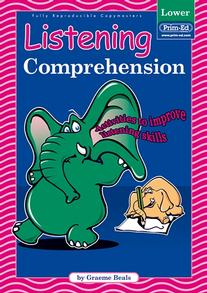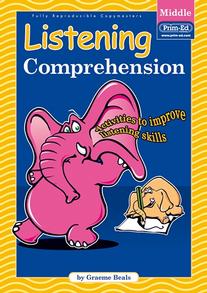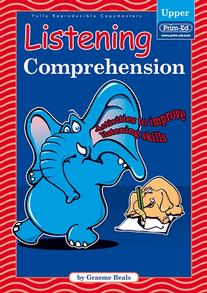-
0
Your cart is currently empty.
-
0
Your cart is currently empty.
Listening Comprehension
Listening comprehension is a crucial skill for all children to develop at primary school. Prim-Ed Publishing publishes a comprehensive range of listening comprehension resources designed to help pupils from Junior Infants to 6th Class develop effective listening skills and improve their understanding of spoken texts.
The listening comprehension worksheets in this series allow for structured and progressive development in the classroom. The activities provide enjoyable and interactive ways to practise essential listening skills while building a solid foundation for effective literacy development.
What is listening comprehension?
Listening comprehension is the ability to understand and process spoken words, phrases, and sentences. It requires active listening, concentration, and quick-thinking skills.
Listening skills develop over time as children learn the language they are exposed to at home, in school, and in their wider environment. Social interactions with their friends, family, and teachers are essential to advance in listening comprehension. But formal instruction and listening skills practice are also important, particularly for those who struggle with language or lack exposure to spoken words.
Why listening comprehension is important
Children who have strong listening skills are better able to comprehend their teacher’s instructions, follow stories, answer questions and complete tasks that involve listening.
Developing listening skills is also essential for progressing in other vital parts of the Primary Language Curriculum, such as reading, writing and speaking. Listening comprehension supports these English language skills by helping children build their vocabulary, improve their grammar usage and increase the accuracy of their pronunciation.
While a child’s ability to listen and comprehend will naturally improve over time, parents and teachers can help foster this development by reading out loud to children and engaging them in structured activities that provide practice and opportunities for progress.
How Prim-Ed Publishing listening comprehension worksheets can help
The activities in Prim-Ed Publishing’s listening comprehension worksheets and books are designed to promote active listening, develop the ability to follow instructions, and improve information retention and memory skills.
The range includes:
- Listening Comprehension photocopiable books: With editions designed for lower, middle and upper levels, these workbooks contain a range of exercises designed to develop each pupil’s accuracy and memory in listening skills.
- Look! Listen! Think!: A series of listening skills books containing photocopiable activities with detailed teacher’s notes.
- ‘Follow Me’ Loop Card Games: A set of interactive card games with the aim of improving auditory discrimination skills that can be used in small groups or with the whole class.
- Sequencing Visual Texts: A teaching resource that provides practice in understanding the order of events through a series of text-based activities. Each activity helps teachers to provide pupils with the necessary support, guidance and practice they need to hone their storytelling, comprehension and oral communication skills.
- Speaking and Listening: A series of books containing progressively more difficult oral language activities that support the learning outcomes of the new Primary Language Curriculum.
Each resource is designed to help teachers guide their pupils in the development of their comprehension and listening skills and allow them to practise and progress within a structured framework.
The activities provide fun, engaging ways for children to improve their understanding and recall of spoken instructions, conversations and literature. With the resources from Prim-Ed Publishing, your pupils will be well on their way to becoming confident listeners.
Teaching listening comprehension in the classroom
Listening comprehension should not be considered a stand-alone skill. Listening skills and speaking, along with other language skills such as reading and writing, should be integrated into the classroom to ensure that pupils are given the opportunity to practise their listening skills across different activities.
When teaching English listening comprehension, it is important for teachers to provide clear instructions and give pupils ample time to process and respond. Teachers can also provide differentiated instruction and support by scaffolding activities to meet different levels of ability.
The best way to teach listening skills and comprehension is to provide pupils with opportunities to practise their listening skills through active listening activities. The following tips will help teachers create a successful learning experience:
- Provide clear instructions and describe expectations for every activity.
- Use simple language that is appropriate for the age group.
- Model good listening skills for your pupils — demonstrate active listening by looking and nodding in response to their comments.
- Encourage pupils to give as much detail as possible when responding with answers.
- Use a variety of activities — such as stories, art, dialogues, role play, and problem-solving tasks — to engage your pupils in the learning experience.
- Encourage pupils to ask questions or provide feedback when responding to what they have heard.
- Enforce rules for speaking and listening in the classroom — make sure that only one person speaks at a time and that all pupils are given a chance to respond.
Strategies for teaching listening comprehension skills
Unlike many other subjects, the teaching of listening comprehension skills is not linear. It is important for teachers to incorporate a variety of strategies and techniques in order to help children practise and progress their listening comprehension skills in English lessons.
Some effective strategies that teachers can use include:
- Pair/group work: Working in pairs or small groups allows pupils to practise their listening comprehension in a safe, supportive environment.
- Storytelling: Storytelling is an effective way to engage pupils and helps to develop their understanding of narrative structure, English language conventions and comprehension skills.
- Questioning: Asking questions encourages children to think critically about what they have heard and helps them to focus and develop their listening skills.
- Listening centres: Creating dedicated listening centres in the classroom will give pupils the opportunity to practise their skills in a quiet, distraction-free environment.
- Printed resources: Providing pupils with printed materials, such as the listening comprehension worksheets and activities available from Prim-Ed Publishing, gives them a chance to practise their listening skills in a more independent way.
Frequently asked questions
How can young children improve their listening comprehension skills?
Young children have short attention spans and are easily distracted, so it’s important to make sure you have their full attention before giving oral instructions or reading out loud. Asking questions, playing listening games, and emphasising body language and gestures during spoken communication are all effective methods for working with young children.
How do you teach listening comprehension in ESL?
When teaching ESL learners, it is important to use simple language and gradually increase the complexity of the material as they progress. Providing visual aids, such as pictures or diagrams, can help to support English language comprehension and listening skills.
What does the Primary Language Curriculum say about listening?
The Primary Language Curriculum notes in Element 2 (Understanding) that listening comprehension skills are crucial for developing vocabulary and sentence structure.

















